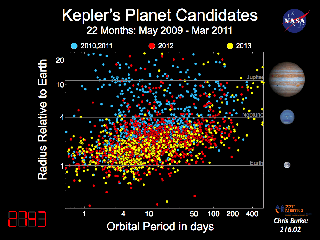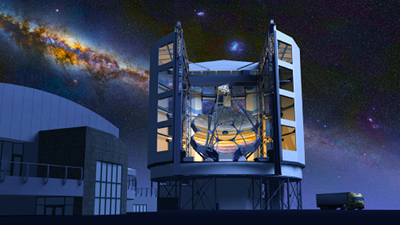Kepler's Planet Candidates: A graph/scatter plot of radius vs period for Kepler planet candidates. Comparing the distributions from 2010-2011 (blue), 2012 (red), and 2013 (yellow), notice how more and more small planets are revealed. This plot excludes "single-transit" events. Period for single transit events must be estimated from the transit duration. Here we demand 2 or more transits for the plot.
Credit: NASA/Kepler mission
In order to answer the new questions that are raised through the Sloan survey, larger telescopes are necessary to study the details of larger categories of astronomical sources. In the instance of the quasars, a bigger survey with a bigger telescope is required because they are so faint (in the optical) and are so infrequently seen in the sky. A larger optical telescope will tell you how bright the objects really are in the optical and a deeper infrared survey over a long period of time will provide a larger sample of quasars to study in order to discover more detailed information about their “norm”.
Studies in the time domain will also provide information in an area with a serious gap: How astronomical sources change with time, in particular stars. The assumption that astronomical sources don’t change has been disproved over and over again. A prime example of the impact of time domain astronomy is NASA’s Kepler Mission which was looking for tiny changes in light coming from stars as planets transited them. Scientists have found thousands of planet candidates already using Kepler data and are continuing to search the data for more candidates.
Astronomers have big dreams. A much larger optical survey telescope that will redo much of what Sloan has done to fainter limits and will prodivde the time-domain coverage of large numbers of objects is called the Large Synoptic Survey telescope, LSST. Among other things, the 8.5-meter telescope will cover over half of the sky every three days and observe objects as much as 100 times fainter than those of the SDSS.
Given the limitation on the size of mirrors in space, a prime advantage of telescopes in spaces is that they are able to produce sharp images, high resolution images undisturbed by the atmosphere from the ground. We are slowly learning to do this with adaptive optics technology. Adaptive optics technology constantly measures the distortions in the atmosphere that cause interference in the imaging of objects in space. The telescope then uses corrective optics to account for and remove the distortions creating an image that is equal to the quality of those taken by Hubble above the atmosphere. The ground-based adaptive optics still have short-comings compared with normal optics in space, but adaptive optics will soon be found on all of the large ground-based optical telescopes.
Giant Magellan Telescope: Artist's rendering of the Giant Magellan Telescope which will employ adaptive optics. It will be a segmented mirror telescope that employs seven of today's largest stiff monolith mirrors as segments. Six off-axis 8.4 meter or 27-foot segments surround a central on-axis segment, forming a single optical surface with a collecting area of 24.5 meters, or 80 feet in diameter. The GMT will have a resolving power 10 times greater than the Hubble Space Telescope.
Credit: Giant Magellan Telescope - GMTO Corporation



